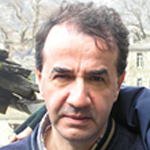

 Associate Prof. Marios Anagnostakis
Associate Prof. Marios Anagnostakis Marios Anagnostakis is Associate Professor at the Nuclear Engineering Department of the National Technical University of Athens (NED-NTUA). He holds a PhD in low energy low activity gamma spectrometry. His research interests include: Ionizing radiations metrology, determination of radionuclides in soil, air and NORM, dosimetric calculations, nuclear related analytical techniques (XRF, INAA), Monte-Carlo simulation etc. He has 28 peer-reviewed publications and more than 40 presentations in International Conferences. He is member of the International Commission on Radionuclide Metrology, Gamma Spectrometry Working Group, ICRM-GSWG and CHERNE Network (Collaboration on Higher Education and Research in Nuclear Engineering).
The term environmental radioactivity is used to describe any radionuclide existing in the environment, either of natural origin or due to human activity. For several decades natural and artificial radioactivity in the environment, have been extensively studied around the world, and nuclear accidents – mainly that of Chernobyl – have led to the development of field of radioecology. Detector systems and techniques, with predominant that of gamma spectrometry, have been constantly developed through the years to meet researchers’ needs and low energy photons are today used quite efficiently for the determination of specific radionuclides, on a routine basis. New approaches and computer software for detector calibration have appeared and factors not usually taken into consideration in the past, such as true-coincidence and random summing corrections are today a prerequisite for quality results.
The study of natural radionuclides in the soil that was originally limited to 226Ra, 232Th and 40K has been extended to include 234Th, 210Pb, 235U and 7Be, partly as a result of advances in detector technology, as well as due to specific needs, such as the study of Depleted Uranium contamination. At the same time research was extended to NORM (Naturally Occurring Radioactive Materials) and TENORM (Technologically Enhanced Naturally Occurring Radioactive Materials) with potentially significant environmental impact, for which significant radioactive equilibrium disturbance is very often observed.
Besides their importance from the radiation protection point of view, many radionuclides are also monitored and used as tracers of environmental processes, such as aerosol and transportation of air masses studies (7Be, 22Na, 40K, 137Cs), soil erosion, sedimentation and geochronology (210Pb, 137Cs), marine ecosystems studies and studies related to climate change (238U and 234Th). All these studies require newly developed and well-designed samplings strategies, specialized sampling and sample preparation techniques and measurements of high accuracy and precision, while the improvement of detection limits is in most cases of vital importance.
This work is a review of environmental radioactivity measurement techniques and their applications. The review is mainly focused on the field of gamma spectrometry, for which difficulties and limitations will be presented, together with future trends, new challenges and applications.